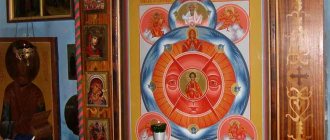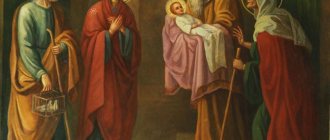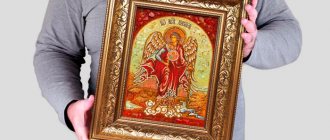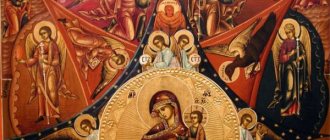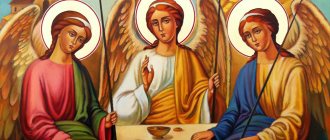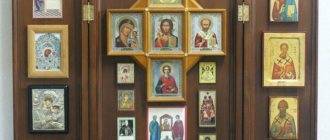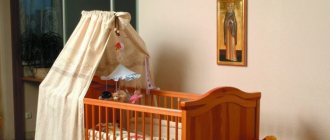Sacred images are endowed with particularly strong energy and accompany people for many centuries, therefore, in the minds of our ancestors, religious beliefs were closely intertwined with beliefs and mysticism. The clergy classify any signs associated with icons as superstitions that are unacceptable for a believer. However, you need to know how to handle the faces of saints in order to protect yourself from harm.
What is an icon?
Icon painting originated many centuries ago. Many adherents of the Christian religion have at least one image in their homes. It can be applied to wood, paper, fabric, iron or other surface.
It is believed that the icon helps to visualize the face of the saint to whom the prayer is addressed.
The clergy note that the request voiced before the image is endowed with special power. The face of the saint helps not only to focus on spiritual bonds, but also to offer prayers with a pure soul and an open heart.
Icons of the former owners of the house
It often happens that when buying a house or apartment, new residents discover abandoned icons. In this case, as in any other, you cannot throw away the icons of the old owners. An icon is a shrine and must be treated with respect. There is nothing wrong with leaving them. But if you are in doubt because of the unknown history of their presence in the house, the icons can be re-consecrated.
In family houses, icons that belonged to deceased relatives are usually kept, which the young people do not want to leave behind. Again, new icons from your home can be taken to the temple or donated if the images have retained their appearance. Many people mistakenly believe that giving and accepting images from someone else’s hands is prohibited, but the church believes that giving them as a gift is a good tradition. The icon cannot harm you, since it is a sacred object. If you doubt its former owners, you can bring it to the temple and ask for it to be consecrated.
What to do with icons that have fallen into disrepair
The face of a saint depicted on some surface can be classified as an icon if it meets two requirements.
They were approved at the Ecumenical Council many centuries ago. The clergy established a dogma on the veneration of icons.
In the modern world, centuries-old requirements for images have been preserved. Images of the faces of saints can be called an icon if 2 criteria are taken into account:
- the image is written taking into account the canons - rules. They are approved at Councils - meetings of clergy;
- The faces of the saints depicted on the icon must be clearly visible.
If the image loses its appearance, gets dirty, or scratches or chips appear on it, then it is subject to restoration.
Why is an icon placed in the coffin of the deceased?
Religious paraphernalia is another matter. The icon in the coffin indicates that the deceased belongs to the Orthodox faith, that he was baptized, led a decent life and is ready for the funeral service. An icon with the face of St. Nicholas the Pleasant is most often placed in a man’s coffin, and the Mother of God in a woman’s coffin. If there is a small icon with a saint that is consonant with the name of the deceased, then they place it. The patronage of a saint after death will help the soul overcome all adversity and find peace in Heaven.
When choosing ritual goods, a person focuses on his duty towards the deceased. After all, organizing a decent funeral in Minsk is the only thing that a living person can do for someone who has passed on to another world.
Ritual goods
What to do with old icons
Many centuries ago, another possibility was taken into account - over time, icons deteriorate and become dilapidated. In order not to store old and damaged images, church ministers decided what to do with them.
Old icons can be:
- restore;
- take it to church;
- burn. But not like trash.
Usually in large churches there are special ovens where old and dilapidated icons are burned.
How to get rid of an icon
Holy faces require respect and reverence. However, there are times when it is necessary to get rid of icons, for example, due to their disrepair or the death of the former owner. Sometimes esotericists advise removing images from the house that have seen a lot of troubles, negativity, and illnesses in their lifetime, since they are overflowing with negative energy and can attract it to their owners.
Whatever the reasons that prompted you to get rid of the icon, it is strictly forbidden to throw it away like ordinary garbage, so as not to bring misfortune on yourself and the whole family.
Belonged to strangers
Despite the fact that the church allows holy images left over from previous owners to be kept in the house, many people prefer to get rid of them. The fact is that icons have the ability to absorb the energy of a person who prays on them. Without knowing the history of the image, you can incur someone else's negativity.
Throwing away church paraphernalia is strictly prohibited - it is considered a great sin. You can solve the problem by taking the image to the temple and leaving it near the altar or donating it to the church.
Remaining from a deceased person
If the previous owner has passed away, then relatives often do not know what to do with the icons correctly. If the deceased was a kind and God-fearing person, then the images that belonged to him can be left behind. It is very likely that they will become a real talisman and amulet for the home.
It is recommended to take the inherited symbol of faith to the temple so that the priest will read a special cleansing prayer and consecrate it, if necessary.
As a last resort, icons of a deceased person can be donated to the church or given to friends.
The most important rule is to never treat sacred images like unnecessary trash. It is strictly forbidden to tear, break, or deform images.
Such a sin may result in severe punishment, including death.
Inherited from the former owners of the house
Sometimes, when purchasing living space, new owners discover images left by the former owners. The priests claim that you can keep such icons for yourself - nothing bad will happen.
If you doubt the history of the image, you can take it to church and re-consecrate it. An icon is a shrine and should be treated accordingly. Therefore, if you do not want to leave sacred images at home, the best solution would be to give them or donate them to the temple.
Dilapidated
Old icons must be taken to the temple. If the image has completely lost its appearance, it will be burned in the church stove. If the icon is only slightly damaged or its colors have faded, then it is likely that one of the poor parishioners will happily take it.
This way one expresses love and respect for deceased relatives.
Another option is to hand over an old icon that needs restoration to a church shop.
Is it possible to burn
Old icons that have completely lost their appearance are allowed to be burned. It is better to entrust this procedure to the clergy, giving them the image. It is allowed to burn the attribute of faith yourself, following certain rules:
- The ceremony should be performed during daylight hours, choosing any day except Sunday.
- Icons are burned separately, in a clean and tidy place, and not in a heap with garbage.
- It is recommended to collect the ashes and bury them in the ground, after reading a prayer before doing this.
An icon is an attribute and symbol of faith. Careful and respectful attitude towards sacred images, regardless of their history and condition, will protect you from numerous troubles and attract goodness and good luck into your life.
What to do if the icon belonged to other people
There are different situations in life. It may also happen that icons that belonged to someone came to a person.
In such cases, church ministers recommend the following manipulations:
- sprinkle the image with holy water;
- take the icon to the temple;
- give for restoration;
- burn.
The clergy emphasize that icons cannot simply be thrown into the trash. This is considered a great sin. If the image is not needed for some reason, it is better to burn it or give it to those who will gladly accept it.
Icons that belonged to strangers
Sometimes old wedding couples remain in houses, icons that are given to the newlyweds during the wedding sacrament, or icons of guardian angels of deceased relatives or old owners of the house. You can keep such images for yourself. An icon is not a talisman; people pray to a saint in front of it, and therefore it doesn’t matter at all who previously owned the shrine and for what reason it appeared among the previous owners. The wedding couple usually consists of the icon of Jesus Christ “Lord Pantocrator” and the Mother of God – “Kazan Mother of God”. These images of saints can move from couple to couple or even end up with a single person, this is acceptable.
An icon is a symbol of faith. Unlike modern paintings, holy images carry an instructive meaning. Each icon is a work of art, with its own history and intention. Many icons very reliably convey the events described in the Gospel, scenes from which are very often used by icon painters. Therefore, they should be treated with respect and awe, and not as a piece of furniture. And even if you decide to say goodbye to the old icon, you need to do this according to the rules, so as not to offend the saint whose face is depicted on the icon, and not to harm yourself through reprehensible actions.
( 5 ratings, average: 4.40 out of 5)
In what cases is the icon not placed in the coffin?
As stated above, the presence of an icon in the coffin indicates the deceased’s admission to the funeral service. Accordingly, for those over whom the priest refuses to perform the ritual, the icon is not placed. List of such people:
- laid hands on themselves,
- God-fighters,
- atheists,
- unbaptized
- of another religion.
An Orthodox clergyman may be present at a funeral, but he does not read the prescribed set of prayers, but only accompanies the deceased to the grave with the words “Holy God.” This way respect for the deceased is expressed.
Why are things placed next to the deceased?
If we talk about ordinary things - toys, a notebook, flowers or a brooch - then placing them in a coffin goes back to pagan traditions. It is by the presence of foreign objects in the grave that anthropologists can accurately indicate whether it was a farmer (presence of a sickle), a warrior (presence of a sword), a hunter (there was a bow nearby) or a spinner (spindle), or a needlewoman (there are needles or other sewing supplies). From the point of view of Christianity, the custom of placing any objects in a coffin rather serves as a method of reassurance for relatives, as if they did everything that the deceased asked for before his death.
Question and answer
Where in the house should icons be located, including the one that was removed from the tomb?
The “red corner”, i.e., the part of the house in which icons are usually placed, is usually located on its eastern side.
Is it possible to put an icon with the face of Jesus Christ in the coffin?
It is not forbidden to place the icon of the Savior next to the deceased. In general, the choice of the icon that will be with the deceased at the funeral service depends on established traditions and the desires of the relatives.
Is it customary for Catholics to place icons in the coffin?
Catholics have a slightly different purpose for icons than Orthodoxy. In addition, the funeral service according to the Catholic rite takes place with the coffin lid closed, so it is not customary to place icons there.
Where should the icon be placed?
After placing the body in the coffin, it is the turn to distribute religious attributes. The aureole is placed on the coffin, a cross is placed around the neck, and the accompanying prayer written on a piece of paper is placed in the hands. Where should the icon be placed? It must be placed on the side so that after saying goodbye a person can kiss it.
Important! If a small icon is not available at a funeral, a large icon is used, which is held by one of the participants in the funeral procession or placed nearby on a music stand.
Why are religious attributes placed next to the deceased?
Religious attributes placed in the coffin have a special purpose. Firstly, it denotes a person’s belonging to a particular faith. Secondly, it indicates that the person was baptized during his lifetime. Thirdly, it determines how ready a person is for the funeral service. If there is only a cross, but no other attributes - a corolla, prayer (Orthodoxy) or a ladder (Old Believers) - then the deceased was baptized, but did not lead such a righteous life as to be allowed to attend the funeral service.
Funeral arrangements



